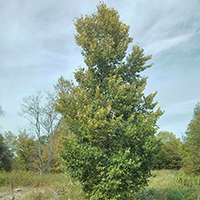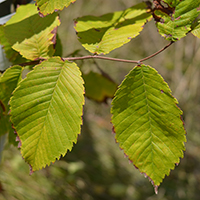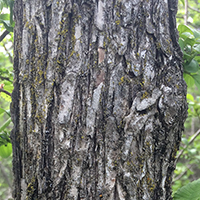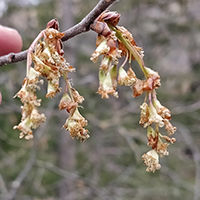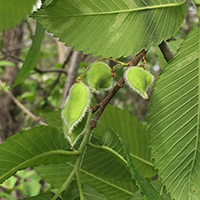What rock elm looks like
Size and shape
- Reaches 25 metres high.
- Trunk up to 75 centimetres in diameter.
- Cylindrical shape.
Leaves
- Leathery leaves (5 to 10 centimetres long).
- Dark green, shiny and smooth upper surface.
- Paler green and hairy lower surface.
- Bright yellow in the fall.
Bark
- Dark grey bark with traces of red.
- Shaggy and furrowed.
- Corky ridges on branches.
Flowers
- Flowers are greenish red and grow in clusters (up to 3 centimetres long).
Fruit
- Oval winged seeds (10 to 15 millimeters).
- Hairy.
Where rock elm is found
Rock elm is primarily found in Southern Ontario south of the Canadian Shield.
What you need to know to grow rock elm
- Moisture: grows best in dry, well drained sites.
- Soil: commonly found on shallow soil over limestone bedrock (hence the common name) but tolerates many soil types.
- Shade: requires full sun for growth.
- Cautions:
- Dutch elm disease: Dutch elm disease is caused by an invasive fungus that develops in tissues under the bark. Foliage begins to wilt and eventually stops growing. Infections usually kill the tree in 1 to 3 years. Control measures include removing dead foliage and branches, avoiding transport and use of wood and injecting fungicides.
Benefits and uses of rock elm
Wildlife benefits
Rock elm is a food source for many species, including:
- rabbits
- white-tailed deer
- squirrels
- many birds
Commercial uses
Rock elm trees produce strong, dependable wood that was once used for piano frames and hockey sticks. Rock elm products are no longer available in commercial quantities.
Fun facts about rock elm
- Rock elm trees can live up to 175 years.
- Rock elm trees produce seeds every 3 to 4 years.
Updated: November 22, 2023
Published: August 22, 2023
